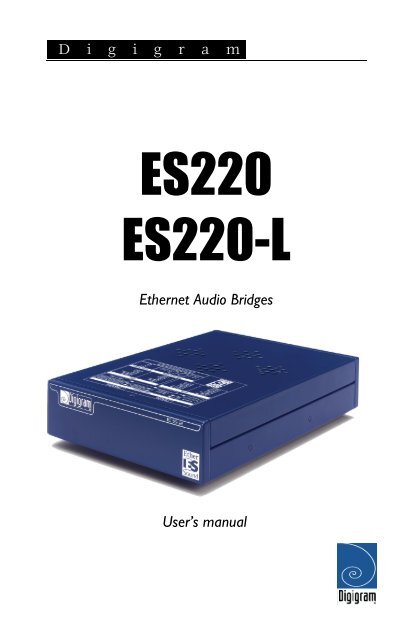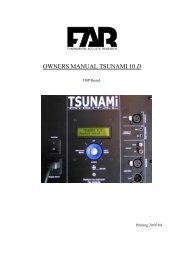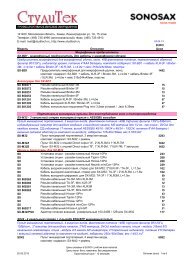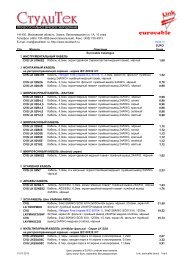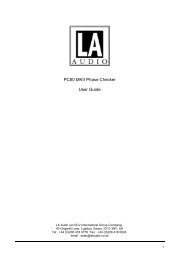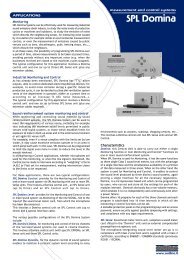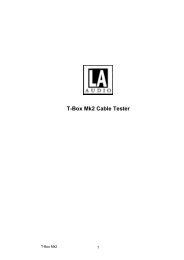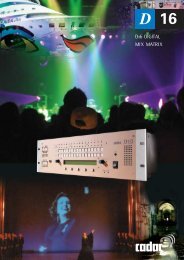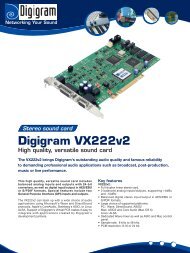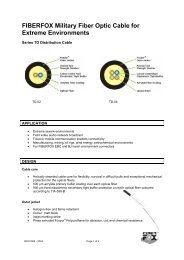ES220 & ES220-L - Digigram
ES220 & ES220-L - Digigram
ES220 & ES220-L - Digigram
Create successful ePaper yourself
Turn your PDF publications into a flip-book with our unique Google optimized e-Paper software.
D i g i g r a m<br />
<strong>ES220</strong><br />
<strong>ES220</strong>-L<br />
Ethernet Audio Bridges<br />
User’s manual
D i g i g r a m<br />
Important Safety Information<br />
read carefully before using this equipment!<br />
Follow these instructions and keep them in a safe place! Keep in mind that<br />
damages due to failure to observe the instructions contained in this manual are not<br />
covered by warranty.<br />
Instructions importantes de sécurité<br />
lire soigneusement avant d'utiliser l'équipement!<br />
Lisez et suivez ces instructions. Conservez les pour consultation ultérieure! Les<br />
dommages dus au non-respect des instructions contenues en ce manuel ne sont<br />
pas couvert par la garantie.<br />
Wichtige Sicherheitshinweise<br />
vor Inbetriebnahme des Gerätes sorgfältig lesen!<br />
Befolgen Sie die Anweisungen und bewahren Sie sie für spätere Fragen auf! Bei<br />
Schäden, die durch Nichtbeachten dieser Bedienungsanleitung verursacht werden,<br />
erlischt der Garantieanspruch!<br />
Do Not Open the<br />
Cabinet<br />
There are no userserviceable<br />
components inside this product.<br />
Opening the cabinet may present a<br />
shock hazard, and any<br />
modification to the product will<br />
void your warranty. If it is<br />
necessary to open the device for<br />
maintenance or advanced<br />
configuration purposes, this is to<br />
be done by qualified personnel<br />
only after disconnecting the power<br />
cord and network cables!<br />
Power supply<br />
The device is to be<br />
connected only to a<br />
power supply as<br />
specified in this<br />
manual and marked on the<br />
equipment. This equipment must<br />
be earthed!<br />
Do not block any of the ventilation<br />
openings!<br />
Humidity<br />
To reduce the risk of fire or shock,<br />
do not expose this device to rain or<br />
moisture. Do not place objects<br />
filled with liquid on this device.<br />
Installation Location<br />
To ensure proper operation and to<br />
avoid safety hazards, the device<br />
must be installed in a 19“ rack<br />
mount chassis. If this is not<br />
possible, place it on a firm and<br />
level surface. Avoid installation in<br />
2<br />
Ne pas ouvrir<br />
l'appareil<br />
L'ouverture du coffret<br />
peut produire un<br />
risque de choc électrique, et toute<br />
modification du produit annule<br />
votre garantie. S'il est nécessaire<br />
d'ouvrir l'appareil pour l'entretien<br />
ou la configuration avancée, cela<br />
doit être fait par du personnel<br />
qualifié, après avoir débranché le<br />
cordon d'alimentation et les câbles<br />
réseaux !<br />
Alimentation<br />
Il est primordial de<br />
connecter l'appareil à<br />
une alimentation<br />
électrique telle que spécifiée dans<br />
ce manuel d´utilisateur et sur le<br />
matériel<br />
même.<br />
Cet équipement doit être raccordé<br />
à la terre !<br />
N'obstruer aucune ouverture de<br />
ventilation !<br />
Humidité<br />
Afin de réduire les risques de feu<br />
ou de choc, n'exposez pas cet<br />
appareil à la pluie ou l'humidité.<br />
Ne placez pas d´objet contenant un<br />
liquide sur l'appareil.<br />
Installation, mise en place<br />
Afin d'assurer le fonctionnement<br />
correct et de minimiser les risques<br />
potentiels liés à la sécurité,<br />
l'appareil doit être installé dans<br />
une baie de montage de type 19<br />
pouces. Si cela ne vous est pas<br />
Throughout this manual,<br />
the lightning bolt<br />
triangle is used to alert<br />
the user to the risk of<br />
electric shock.<br />
The exclamation point<br />
triangle is used to alert<br />
the user to important<br />
operating or maintenance<br />
instructions.<br />
Gerät nicht öffnen<br />
Öffnen des Geräts<br />
kann eine Gefährdung<br />
durch Stromschlag<br />
und Erlöschen der Garantie zur<br />
Folge haben. Reparaturarbeiten<br />
und Änderungen der<br />
Hardwarekonfiguration dürfen nur<br />
von qualifiziertem Personal nach<br />
entfernen der Strom- und<br />
Netzwerkkabel durchgeführt<br />
werden.<br />
Stromversorgung<br />
Das Gerät darf nur<br />
mit der in dieser<br />
Bedienungsanleitung<br />
und auf dem<br />
Gerät angegebenen<br />
Stromversorgung<br />
betrieben<br />
werden. Erdung ist zu<br />
gewährleisten!<br />
Belüftungsschlitze<br />
nicht<br />
verdecken!<br />
Wasser und Feuchtigkeit<br />
Um Brand- oder<br />
Stromschlagrisiken zu vermeiden,<br />
darf das Gerät nicht mit<br />
Feuchtigkeit in Berührung<br />
kommen.<br />
Aufbau des Geräts<br />
Um den einwandfreien Betrieb zu<br />
gewährleisten<br />
und<br />
Sicherheitsrisiken zu vermeiden,<br />
muss das Gerät in einem 19-Zoll<br />
Baugruppenrahmen montiert<br />
werden. Nur wenn dies nicht<br />
möglich ist, stellen Sie das Gerät<br />
auf einen festen, waagerechten
extremely hot or cold locations, or<br />
in an area that is exposed to direct<br />
sunlight or heating equipment.<br />
Avoid moist or humid locations.<br />
Cleaning<br />
Clean only with a soft, dry cloth. If<br />
necessary, after disconnecting the<br />
unit’s cables, wipe it with a soft<br />
cloth dampened with mild soapy<br />
water, then with a fresh cloth with<br />
clean water. Wipe dry immediately<br />
with a dry cloth. NEVER use<br />
benzene, aerosol cleaners, thinner,<br />
alcohol or any other volatile<br />
cleaning agent. Do not use abrasive<br />
cleaners, which may damage the<br />
finish of metal or other parts.<br />
Refer all servicing to qualified<br />
service personnel!<br />
Servicing is required when the<br />
apparatus has been damaged in<br />
any way, such as power supply<br />
cord or plug is damaged, liquid<br />
has been spilled, the apparatus has<br />
been exposed to rain or moisture,<br />
does not operate normally, or has<br />
been dropped.<br />
Moving the device<br />
Before moving the unit, be certain<br />
to disconnect any cables that<br />
connect with other components.<br />
possible, placez le sur une surface<br />
solide et plane.<br />
Evitez une installation dans des<br />
endroits très chauds ou très froids<br />
ainsi que dans des lieux exposés<br />
directement au soleil. Evitez les<br />
lieux présentant un excès<br />
d'humidité.<br />
Nettoyage<br />
Nettoyez uniquement avec un<br />
chiffon doux et sec. Si nécessaire,<br />
après avoir débranché le cordon<br />
d´alimentation, essuyez-le avec un<br />
chiffon doux humidifié avec de<br />
l´eau savonneuse puis rincez le á<br />
l´aide d un chiffon propre et d´eau<br />
claire.<br />
Séchez-le immédiatement avec un<br />
chiffon sec. N'utilisez JAMAIS<br />
d´essence, de nettoyants en<br />
aérosols, d´alcool ou tout autre<br />
agent nettoyant volatile. N'utilisez<br />
pas de produits nettoyants abrasifs<br />
qui pourraient endommager les<br />
finitions métalliques ou d´autres<br />
pièces.<br />
Réparation<br />
Lorsque l'appareil a été<br />
endommagé quelle qu'en soit la<br />
cause ou qu'il ne fonctionne pas<br />
normalement, toute réparation doit<br />
être effectuée par du personnel<br />
qualifié. Avant de transporter<br />
l´unité, assurez-vous d´avoir bien<br />
déconnecté le cordon<br />
d'alimentation ainsi que tous les<br />
câbles la reliant à d´autres<br />
appareils.<br />
<strong>ES220</strong> & <strong>ES220</strong>-L<br />
Ethernet Audio Bridges<br />
Untergrund. Meiden Sie<br />
Standorten in den Nähe von<br />
Wärme- oder Feuchtigkeitsquellen<br />
sowie direkte Sonneneinstrahlung.<br />
Reinigen des Geräts<br />
Säubern Sie das Gerät nur mit<br />
einem weichen, trockenen Tuch.<br />
Bei Bedarf verwenden Sie ein mit<br />
mildem Seifenwasser befeuchtetes<br />
Tuch, nachdem Sie die<br />
Netzanschlusskabel aus der<br />
Steckdose gezogen haben,<br />
anschliessend ein weiches, mit<br />
klarem Wasser befeuchtetes Tuch.<br />
Trocken Sie das Gerät sofort im<br />
Anschluss. Keinesfalls Benzol,<br />
Verdünner oder sonstige starke<br />
Lösungsmittel<br />
oder<br />
Scheuerreiniger verwenden, da<br />
hierdurch das Gehäuse beschädigt<br />
werden könnte.<br />
Lassen Sie etwaige Reparaturen<br />
nur von qualifizierten<br />
Fachleuten durchführen!<br />
Sollten das Netzkabel oder der<br />
Netzstecker beschädigt sein, oder<br />
sollte das Gerät selbst beschädigt<br />
worden sein (z. B. durch<br />
Eindringen von Feuchtigkeit durch<br />
Fall auf den Boden), oder sollte es<br />
nicht<br />
ordnungsgemäss<br />
funktionieren oder eine deutliche<br />
Funktionsabweichung aufweisen,<br />
so ist es von qualifizierten<br />
Fachleuten zu reparieren.<br />
Copyright 2005 <strong>Digigram</strong>. All rights reserved.<br />
No portion of this manual may be reproduced without prior written consent from <strong>Digigram</strong>. The copyright protection<br />
claimed here includes photocopying, translation and/or reformatting of the information contained in this manual.<br />
While every effort has been made to ensure accuracy, <strong>Digigram</strong> is not responsible for errors and omissions, and reserves the<br />
right to make improvements or changes in the products and programs described without notice.<br />
<strong>Digigram</strong>, EtherSound, <strong>ES220</strong> and <strong>ES220</strong>-L are registered trademarks or trademarks of <strong>Digigram</strong> S.A.. All other trademarks are<br />
property of their respective holders.<br />
La technologie EtherSound est protégée par des brevets et des demandes de brevet internationales, y compris, mais pas<br />
limitée à :<br />
WO 03/023759, FR 2 829 655, USA 2003/0050989<br />
3
D i g i g r a m<br />
Table of Contents<br />
INFORMATION FOR THE USER............................................................................. 6<br />
CONTENTS OF THIS PACKAGE ............................................................................. 7<br />
<strong>ES220</strong> & <strong>ES220</strong>-L rear panels ...........................................................................................8<br />
INSTALLATION ........................................................................................................................ 9<br />
Before mounting devices in a rack… ..........................................................................9<br />
Internal settings ...................................................................................................................9<br />
Setting the EtherSound channels (<strong>ES220</strong> and <strong>ES220</strong>-L).......................................... 9<br />
Input/Output configuration (<strong>ES220</strong>-L only)................................................................... 9<br />
Nominal input level.............................................................................................................. 9<br />
Connecting your EtherSound device ..........................................................................9<br />
Power supply..........................................................................................................................9<br />
Network .................................................................................................................................10<br />
Connecting a computer<br />
to manage the EtherSound network .................................................................11<br />
Audio ........................................................................................................................................11<br />
GPIO.........................................................................................................................................11<br />
Remote set-up by means of configuration software ...............................11<br />
Firmware update..............................................................................................................12<br />
SPECIFICATIONS...................................................................................................................13<br />
Configuration............................................................................................................................13<br />
Parameters.................................................................................................................................13<br />
Inputs/Outputs.........................................................................................................................14<br />
Connectivity...............................................................................................................................14<br />
Audio specifications..............................................................................................................15<br />
Synchronization ......................................................................................................................15<br />
4
<strong>ES220</strong> & <strong>ES220</strong>-L<br />
Ethernet Audio Bridges<br />
APPENDIX A:<br />
BOARD LAYOUT ..................................................................................................................16<br />
APPENDIX B:<br />
SETTING THE ETHERSOUND CHANNELS MANUALLY............17<br />
APPENDIX C:<br />
AUDIO CONNECTOR.......................................................................................................18<br />
Pinout............................................................................................................................................. 18<br />
APPENDIX D:GPIO CONNECTOR.....................................................................19<br />
General Purpose Inputs (GPIs).................................................................................... 19<br />
General Purpose Outputs (GPOs) ............................................................................ 19<br />
GPO open collector specifications...................................................................... 20<br />
Pinout............................................................................................................................................. 20<br />
APPENDIX E:<br />
SETTING THE INTERNAL JUMPERS .............................................................21<br />
IN/OUT selection (<strong>ES220</strong>-L only) .............................................................................. 22<br />
End of bi-directional loop................................................................................................. 22<br />
Audio extraction (downstream/upstream)......................................................... 22<br />
Audio insertion........................................................................................................................ 23<br />
Nominal input level (<strong>ES220</strong>, <strong>ES220</strong>-L in mode “IN”/Master)................ 23<br />
APPENDIX F: CABLES....................................................................................................24<br />
<strong>ES220</strong>: analog cable delivered by <strong>Digigram</strong> (optional):........................ 24<br />
Wiring diagram – analog cable <strong>ES220</strong>.............................................................. 24<br />
Wiring - analog cable with 2 inputs / 2 outputs (<strong>ES220</strong>)...................... 24<br />
<strong>ES220</strong>-L: analog cable with 2 outputs (optional): ..................................... 25<br />
Wiring diagram – analog cable with 2 outputs <strong>ES220</strong>-L...................... 25<br />
Wiring – analog cable with 2 outputs <strong>ES220</strong>-L........................................... 25<br />
<strong>ES220</strong>: analog cable with 2 inputs (optional):.............................................. 26<br />
Wiring diagram – analog cable with 2 outputs <strong>ES220</strong>........................... 26<br />
Wiring – analog cable with 2 outputs <strong>ES220</strong>-L........................................... 26<br />
APPENDIX G:<br />
POWER SUPPLY......................................................................................................................27<br />
5
D i g i g r a m<br />
Thank you for purchasing <strong>Digigram</strong> EtherSound <strong>ES220</strong>(-L)!<br />
EtherSound <strong>ES220</strong> and <strong>ES220</strong>-L are <strong>Digigram</strong> products<br />
incorporating the EtherSound technology. They allow to easily and<br />
economically insert into an EtherSound network or extract two<br />
digital audio channels (2 + 2 in the case of <strong>ES220</strong>) from it, using<br />
standard Ethernet components (CAT5 cables and switches).<br />
<strong>ES220</strong> converts two analog audio signals into two EtherSound<br />
channels and two EtherSound channels into analog audio signals,<br />
while <strong>ES220</strong>-L is configurable via jumpers: it either converts two<br />
analog audio channels into digital audio and inserts them into an<br />
EtherSound network, or it extracts two digital channels from the<br />
network to convert them into analog audio signals. Both feature<br />
GPIOs and take advantage of EtherSound's simple, nearly instant<br />
set-up.<br />
EtherSound <strong>ES220</strong> and <strong>ES220</strong>-L allow audio distribution with a<br />
flexibility going well beyond the possibilities of analog audio<br />
installations. Routing can be adapted remotely to the changing<br />
needs of the audio installation.<br />
For more information on the EtherSound technology we invite you to<br />
visit our web site where several documents (in English) are available<br />
for download.<br />
INFORMATION FOR THE USER<br />
This equipment has been tested and found to comply with the limits for a<br />
CLASS B digital device, pursuant to Part 15 of the FCC Rules and with the<br />
following European and international Standards for:<br />
Electrical safety:<br />
Europe: EN60950, 3rd edition<br />
European Directive 73/23/CEE<br />
“Low Voltage Directive”<br />
International: EN60950, 3rd edition<br />
Elecromagnetic compatibility:<br />
Europe : EN55022:1998 + A1:2000, Class B /<br />
EN55024: 1998 + A1:2001<br />
European Directive 89/336/CEE on electromagnetic<br />
compatibility<br />
International: CISPR22:1997 + A1:2000 CLASS B<br />
United States: FCC Rules-Part 15-Class B<br />
6
<strong>ES220</strong> & <strong>ES220</strong>-L<br />
Ethernet Audio Bridges<br />
In order to guarantee compliance with the above standards in an installation, the<br />
following must be done:<br />
• the provided cables must not be modified.<br />
• additional cables used must have their respective shield connected to each<br />
extremity.<br />
Operation is subject to the following two conditions: (1) This device may not cause<br />
harmful interference, and (2) This device must accept any interference received,<br />
including interference that may cause undesired operation.<br />
If this equipment does cause harmful interference to radio or television reception, which<br />
can be determined by turning the equipment off and on, the user is encouraged to try to<br />
correct the interference by one or more of the following measures:<br />
* reorient or relocate the receiving antenna<br />
* increase the separation between the equipment and the receiver<br />
* connect the equipment into an outlet on a circuit different from that of the receiver<br />
* consult the dealer or an experienced audio television technician.<br />
Note: Connecting this device to peripheral devices that do not comply with CLASS B<br />
requirements or using an unshielded peripheral data cable could also result in<br />
harmful interference to radio or television reception. The user is cautioned<br />
that any changes or modifications not expressly approved by the party<br />
responsible for compliance could void the user’s authority to operate this<br />
equipment. To ensure that the use of this product does not contribute to<br />
interference, it is necessary to use shielded I/O cables.<br />
CONTENTS OF THIS PACKAGE<br />
The ES2 package consists of the following components:<br />
* one <strong>ES220</strong> or one <strong>ES220</strong>-L 1/3 U rack device<br />
* counterpart plug for the power connector<br />
* the user’s manual at hand.<br />
* a power supply (optional)<br />
* an analog cable 2 inputs / 2 outputs (optional with <strong>ES220</strong>)<br />
* an analog cable 2 outputs (optional with <strong>ES220</strong>-L)<br />
* an analog cable 2 inputs (optional with <strong>ES220</strong>-L)<br />
Also available for <strong>ES220</strong> & <strong>ES220</strong>-L:<br />
* 1U 19 inch rack to mount up to three <strong>ES220</strong> or <strong>ES220</strong>-L<br />
(optional, including two blind panels and fastenings)<br />
* Mounting bracket for under-table fixing<br />
(optional, including fastenings)<br />
7
D i g i g r a m<br />
<strong>ES220</strong> & <strong>ES220</strong>-L rear panels<br />
1<br />
Audio<br />
connector<br />
2<br />
GPIO<br />
connector<br />
3<br />
Network<br />
connectors<br />
4<br />
Power supply<br />
connector<br />
1. Audio connectors<br />
On <strong>ES220</strong>, a Sub-D 15 connector is used to input two balanced analog signals<br />
and to output two balanced analog signals.<br />
On <strong>ES220</strong>-L, only one of these two functions is accessible depending on the<br />
configuration selected (for connector pinout see appendix C).<br />
2. Network connectors<br />
These two EtherCon TM Neutrik TM RJ45 connectors allow for a steady and<br />
reliable connection to the EtherSound network. The “IN” port allows<br />
connecting the <strong>ES220</strong> to the equipment upstream, while the “OUT” port<br />
allows connecting the <strong>ES220</strong> to the equipment downstream. When an <strong>ES220</strong><br />
receives a descending stream on its “IN” port, it transmits it to its “OUT” port,<br />
after - if required - having injected two EtherSound channels (if this device is<br />
not the last element of the EtherSound chain). When an <strong>ES220</strong> receives an<br />
ascending stream on its “OUT” port, it transmits it to its “IN” port, after - if<br />
required - having injected two EtherSound channels (if this device is not the<br />
Primary Master). For more details, see the document “EtherSound Overview”<br />
(available on our Web site).<br />
3. GPIO connector<br />
This connector allows setup of external control and monitoring devices<br />
through configurable and protected General Purpose Inputs and Outputs. See<br />
appendix D dedicated to the GPIOs for more details.<br />
Note: the GPIO port is managed by configuration software only.<br />
4. Power supply connector<br />
4-pin Mini DIN connector (for the connector pinout see it appendix G).<br />
8
INSTALLATION<br />
<strong>ES220</strong> & <strong>ES220</strong>-L<br />
Ethernet Audio Bridges<br />
Before mounting devices in a rack…<br />
Internal settings<br />
Note: These operations require opening of the cabinet and shall be done<br />
by qualified personnel only.<br />
Setting the EtherSound channels (<strong>ES220</strong> and <strong>ES220</strong>-L)<br />
Four decimal rotary switches on the EtherSound board inside the device<br />
determine whether the assignment of the EtherSound channels to the inputs<br />
or outputs of <strong>ES220</strong>(-L) is done locally or remotely by configuration software.<br />
(to modify this setting, see appendix B).<br />
By default, the devices are parameterized for software control (factory setting).<br />
Input/Output configuration (<strong>ES220</strong>-L only)<br />
On <strong>ES220</strong>-L, a jumper makes it possible to parameterize whether the<br />
equipment adds two channels to the network EtherSound (Master) or restores<br />
two channels (Slave); for more details, please refer to appendix E of this<br />
manual).<br />
By default, the devices are parameterized in order to restore two channels<br />
from the network (Slave).<br />
Nominal input level<br />
The nominal input level can be configured via internal jumpers. The default<br />
value is + 4 dBu, it can be set to -10 dBu (for more details, please refer to<br />
appendix E of this manual).<br />
Connecting your EtherSound device<br />
It is recommended to establish all connections before powering up the device.<br />
Power supply<br />
Before plugging the power cord, make sure that:<br />
• the power cord is not damaged<br />
• the AC outlet used is properly earthed.<br />
Note: Just like for any other audio system, power the individual devices up<br />
following the audio path and power down in the opposite direction.<br />
Do not allow anything to rest on the power cable. Keep the power cable away<br />
from where people could trip over it.<br />
9
D i g i g r a m<br />
Network<br />
The network connections are established via two Neutrik TM EtherCon TM RJ45<br />
receptacles. Connection is very easy: use the connector labeled “IN” connect<br />
the equipment with the next upstream device, the connector labeled “OUT” to<br />
connect the equipment with the neighbored downstream device of the<br />
EtherSound network.<br />
The Neutrik TM EtherCon TM RJ45 provide secure connection through a latching<br />
system. To disconnect the cable from the device, press the latch, then<br />
withdraw the cable while maintaining the latch pushed.<br />
If you use an <strong>ES220</strong>(-L) as Primary Master, the “IN” port may be connected to<br />
a control computer for system configuration (if this connection is not<br />
established through a switch, a crossover cable is required!).<br />
Example 1: point-to-point transmission of two audio channels<br />
This application is very easy with EtherSound <strong>ES220</strong> and <strong>ES220</strong>-L.<br />
Connect a standard Ethernet cable between the “OUT” port of an <strong>ES220</strong> or an<br />
<strong>ES220</strong>-L configured as Master and the “IN” port of an <strong>ES220</strong> or an <strong>ES220</strong>-L<br />
configured as Slave. Select the EtherSound channels on both devices in<br />
accordance with each other (see chapter “Setting the EtherSound channels“).<br />
Example 2: adding more devices<br />
You can easily insert further <strong>ES220</strong>(-L) devices to build a simple daisy chain.<br />
There are only two rules to follow:<br />
The first device in the chain is necessarily the Primary Master.<br />
Install the devices in the chain starting from the Primary Master; connect its<br />
“OUT” port to the “IN” port of the next device, connect its “OUT” port to the<br />
“IN“ port of the following device, and so on.<br />
Example 3: more complex architectures<br />
System topology may be daisy chain, star, or a combination of both. The first<br />
device in a network, such as an EtherSound <strong>ES220</strong>, provides the master clock<br />
for the entire network.<br />
Connect its “OUT” port with the “IN” port of the following EtherSound<br />
device.<br />
Repeat this step for each device in the network. The maximum distance<br />
between two devices connected via a horizontal CAT5 cable is approximately<br />
90 meters (328 feet). Using patch cable, this distance is about 20 m (65 ft.).<br />
Intermediate switches or fiber optic links may be used to considerably<br />
increase this distance.<br />
10
<strong>ES220</strong> & <strong>ES220</strong>-L<br />
Ethernet Audio Bridges<br />
Connecting a computer to manage the EtherSound<br />
network<br />
To connect a PC directly to an <strong>ES220</strong>(-L), it must be equipped with a network<br />
card. Use a crossover Ethernet cable to connect the network card to the “IN”<br />
port of the Primary Master.<br />
You can also access the Primary Master through a conventional Ethernet<br />
network; in this case, use a standard Ethernet cable (e. g. connected to a<br />
switch)<br />
Audio<br />
The pinout of the connector is depicted on the label on top of the device:<br />
These balanced inputs/outputs are can be used with unbalanced audio sources<br />
and destinations: just wire both cold pin and ground pin on <strong>ES220</strong>(-L) to the<br />
ground of the unbalanced signal and the hot pin to the signal. Note that in<br />
this case the unbalanced output signal is multiplied by two (+6 dB), it is thus<br />
necessary to reduce the output gain (-6 dB) in order not to saturate the signal.<br />
By default, the nominal input/output level of an <strong>ES220</strong> or an <strong>ES220</strong>-L is<br />
+4 dBu.<br />
On <strong>ES220</strong>(-L) the nominal input level can be set to +10 dBu via internal<br />
jumpers (for more details see appendix E: Setting the internal jumpers).<br />
The values of the nominal output level can be adjusted for each channel<br />
through management software and stored in the ES8out device.<br />
GPIO<br />
<strong>ES220</strong> and <strong>ES220</strong>-L are shipped with four GPIs and four GPOs on a 15-pin<br />
Sub-D connector. For details see Appendix D.<br />
Note:<br />
the GPIO port is managed by configuration software only.<br />
Remote set-up by means of configuration software<br />
To manage the device remotely using configuration software, the rotary<br />
switches must be set manually to any value ranging between 65 and 99<br />
(factory setting). Use of the configuration software allows for advanced<br />
channel allocation; for software details, please refer to the online help file.<br />
<strong>ES220</strong> and <strong>ES220</strong>-L can be managed by <strong>Digigram</strong>’s configuration software<br />
EScontrol. Please download the required software indicated hereafter from<br />
www.digigram.com, Downloads-Applications, EScontrol and install it in this<br />
order: the EtherSound driver (EtherSound Runtime), the specific DLLs to<br />
manage <strong>Digigram</strong> products (ES <strong>Digigram</strong> Products Runtime), and the EScontrol<br />
application.<br />
Note:<br />
This operation is only necessary if software control is needed.<br />
11
D i g i g r a m<br />
<strong>ES220</strong> and <strong>ES220</strong>-L may also be managed through configuration software<br />
edited by <strong>Digigram</strong> development partners.<br />
To uninstall the software go to Add/Remove programs in the Windows<br />
Control Panel.<br />
Firmware update<br />
<strong>Digigram</strong> may decide to publish firmware updates. It may then become<br />
necessary to upgrade your devices. In this case please refer to the respective<br />
documentation provided with the firmware upgrade tool.<br />
12
SPECIFICATIONS<br />
<strong>ES220</strong> & <strong>ES220</strong>-L<br />
Ethernet Audio Bridges<br />
Configuration<br />
Size<br />
Power supply<br />
(optional)<br />
Temp / humidity<br />
(non-condensing)<br />
Operating :<br />
Storage :<br />
Power consumption<br />
Net weight<br />
1/3 U 19“ rack : 42 x 146.5 x 210 mm<br />
100 – 240 VAC, 47-63 Hz<br />
5 V / 3 A<br />
WARNING Do not open the power supply<br />
module. It contains hazardous voltages. There<br />
are no user-serviceable parts inside.<br />
0 °C – 50 °C / 0% - 95%<br />
-5 °C – 70 °C / 0% - 95%<br />
2 A max.<br />
0.93 kg (∼2.06 lbs)<br />
Parameters<br />
Hardware Software *<br />
Audio channel selection • •<br />
Inputs/outputs ** • -<br />
End of bi-directional loop • •<br />
Audio extraction<br />
upstream/downstream • •<br />
Audio insertion<br />
upstream/downstream - •<br />
Nominal input level • -<br />
Analog output gain -<br />
•<br />
Note:<br />
for manual hardware configuration set the rotary switches to a value<br />
between 01 and 64, channels 65 through 99 set the device to remote<br />
software configuration<br />
*<br />
Windows 2000/XP compatible EtherSound configuration software such as<br />
<strong>Digigram</strong>s ‘EScontrol’<br />
**<br />
<strong>ES220</strong>-L only<br />
13
D i g i g r a m<br />
Inputs/Outputs<br />
Analog audio<br />
Impedance<br />
Nominal input level<br />
Maximum input level<br />
Nominal output level<br />
Maximum output level<br />
Analog output gain<br />
<strong>ES220</strong><br />
2 balanced analog<br />
mono line inputs ∗<br />
AND<br />
2 servo-balanced<br />
analog mono line<br />
inputs ∗∗<br />
22.2 kΩ<br />
<strong>ES220</strong>-L<br />
2 balanced analog<br />
mono line inputs ∗<br />
OR<br />
2 servo-balanced<br />
analog mono line<br />
inputs ∗∗<br />
+4 dBu or -10 dBV<br />
(selectable by means of internal jumpers)<br />
+22 dBu or +10 dBV<br />
(selectable by means of internal jumpers)<br />
+4 dBu<br />
(software adjustable)<br />
+22 dBu<br />
(software adjustable)<br />
from -72 dBu to 0 dB<br />
(software adjustable)<br />
Connectivity<br />
Analog audio<br />
EtherSound<br />
GPIO<br />
1 15-pin Sub-D<br />
2 EtherCon female RJ45 compatible<br />
(connections “IN”/“OUT”)<br />
4 inputs and 4 outputs on 15-pin Sub-D<br />
∗ can be used with unbalanced signals<br />
∗∗ electronically servo-balanced outputs provide automatic level adjustment to accommodate<br />
either balanced or unbalanced lines<br />
14
<strong>ES220</strong> & <strong>ES220</strong>-L<br />
Ethernet Audio Bridges<br />
Audio specifications<br />
<strong>ES220</strong> & <strong>ES220</strong>-L<br />
Sampling frequencies<br />
available<br />
A/D and D/A converter<br />
resolution<br />
Frequency response at 48<br />
kHz<br />
Dynamic range –60dBfs with<br />
Fs=48 kHz (20 Hz/20 kHz,<br />
unweighted)<br />
Distortion + noise at 1 kHz<br />
(-1 dBfs with Fs=48 kHz)<br />
Phase difference between<br />
channels: 20 Hz/20 kHz<br />
Analog channel crosstalk:<br />
at 1 kHz<br />
at 15 kHz<br />
(0 dBfs with Fs=48 kHz)<br />
48 kHz or 44.1 kHz<br />
(Primary Master: 48 kHz only)<br />
24 bits<br />
20 Hz -20 kHz: ±0.2 dB<br />
Inputs:<br />
D i g i g r a m<br />
APPENDIX A: BOARD LAYOUT<br />
3<br />
4<br />
1 2<br />
5<br />
6<br />
7<br />
1<br />
Audio In<br />
Channel<br />
selection<br />
2<br />
Audio Out<br />
Channel<br />
selection<br />
3<br />
Light<br />
Emitting<br />
Diode<br />
4<br />
Extraction<br />
Audio<br />
Amont/Aval<br />
5<br />
IN/OUT<br />
selection<br />
(<strong>ES220</strong>-L only)<br />
6<br />
End of bidirectional<br />
loop<br />
7<br />
Nominal<br />
input level<br />
(<strong>ES220</strong><br />
uniquement)<br />
Factory setting –<br />
Do not modify!<br />
The jumpers marked show the default positions for the normal mode of<br />
operation; this adjustment MUST NOT be modified. These jumpers are<br />
reserved for maintenance purposes.<br />
16
<strong>ES220</strong> & <strong>ES220</strong>-L<br />
Ethernet Audio Bridges<br />
APPENDIX B:<br />
SETTING THE ETHERSOUND CHANNELS<br />
MANUALLY<br />
3<br />
1 2<br />
1<br />
Audio IN<br />
2<br />
Audio OUT<br />
3<br />
Light Emitting Diode<br />
(For the position of the rotary switches on the board see appendix A)<br />
The two rotary switches on the left (Audio IN) allow encoding the channels to<br />
transport the audio coming from the analog inputs. The two rotary switches<br />
on the right (Audio OUT) allow encoding the channels to be played on the<br />
analog outputs. In every pair, the rotary switch on the left is the “tens“<br />
position and the rotary switch on the right is the “ones“ position. Channels 01<br />
to 64 are reserved for manual set-up, channels 65 to 99 set the device remote<br />
configuration.<br />
Software configuration mode is indicated by a lightened red<br />
electroluminescent diode.<br />
In position 00 of the rotary switches the audio is “Mute”: in input mode no<br />
EtherSound channel inserted, in output mode no sound played.<br />
To manually set the EtherSound channels to be used by the device, configure<br />
the number of the EtherSound channel to be assigned to the first analog input<br />
or output by means of a small screw-driver.<br />
Example: to assign channel no. 24 the first EtherSound channel, set the<br />
left switch to “2”, the right one to “4”.<br />
The other channel is assigned subsequently (In our example: 25).<br />
The factory preset is 90, thus the control is done remotely by software.<br />
Note: On <strong>ES220</strong>-L, only one pair of rotary switches is active, depending on<br />
the selected configuration: inputs OR outputs.<br />
Light Emitting Diode (3)<br />
This red LED indicates whether the EtherSound channel selection is done<br />
manually by hardware (LED off) or remotely by software (LED on).<br />
17
D i g i g r a m<br />
APPENDIX C:<br />
AUDIO CONNECTOR<br />
On <strong>ES220</strong>, a Sub-D 15 connector is used to input two balanced analog signals<br />
and to output two balanced analog signals.<br />
On <strong>ES220</strong>-L, only one of these two functions is accessible depending on the<br />
configuration selected (for connector pinout see appendix D).<br />
Pinout<br />
8 7 6 5 4 3 2 1<br />
15 14 13 12 11 10 9<br />
15-pin Sub-D connector<br />
Pin # Signal Pin # Signal<br />
1 OUT 2 – (R) 9 OUT 2 + (R)<br />
2 Ground 10 OUT 1 – (L)<br />
3 OUT 1 + (L) 11 Ground<br />
4 Ground 12 Ground<br />
5 Ground 13 IN 2 + (R)<br />
6 IN 2 – (R) 14 Ground<br />
7 IN 1 + (L) 15 IN 1 – (L)<br />
8 Ground<br />
18
APPENDIX D:<br />
GPIO CONNECTOR<br />
<strong>ES220</strong> & <strong>ES220</strong>-L<br />
Ethernet Audio Bridges<br />
<strong>ES220</strong> and <strong>ES220</strong>-L have four TTL 5 V compatible GPIs and four open<br />
collector GPOs. GPIs allow defining statuses read by the EtherSound<br />
configuration software, GPOs can be used by the EtherSound configuration<br />
software for remote control of external devices.<br />
General Purpose Inputs (GPIs)<br />
Schematic diagrams show the particular design for each GPI. The GPI status<br />
can be either 1 (=ON) or 0 (=OFF). It is read at “0” as soon as the system<br />
connected to GPI provides a tension higher than 2.5 V without ever exceeding<br />
5 V. Otherwise, GPI is read at “1”.<br />
Note:<br />
Pin 1 delivering +5 V electric potential and pin 6 being connected to ground<br />
(0 V), they have to be used in the configuration of the GPIs.<br />
GPI<br />
GPI status<br />
General Purpose Outputs (GPOs)<br />
The <strong>ES220</strong>(-L) GPOs are “open collector” outputs. They use the same<br />
reference for 0 V and the same protection reference. The protection reference<br />
must be connected to the highest potential that may ever be connected to<br />
GPOs.<br />
The GPOs respond to commands of the configuration and management<br />
software sent by the Primary Master. If written at “1”, the GPO closes the<br />
linked open collector. If written at “0”, the GPO opens the linked open<br />
collector.<br />
Note:<br />
Pin 6 being connected to ground (0 V) and pin 11 being used as protection<br />
reference for the GPOs, they have to be used in the configuration of the GPOs.<br />
GPO command<br />
Protection reference<br />
GPO status<br />
19
D i g i g r a m<br />
GPO open collector specifications<br />
Maximum power switching capability all GPOs<br />
included<br />
Maximum switching current (DC) per GPO<br />
Maximum switching direct voltage<br />
1 W<br />
500 mA<br />
50 V<br />
Pinout<br />
8 7 6 5 4 3 2 1<br />
15 14 13 12 11 10 9<br />
15-pin Sub-D connector<br />
Pin # Signal Pin # Signal<br />
1 VCC 9 Reserved<br />
2 Reserved 10 Reserved<br />
3 Reserved 11 common OUT<br />
4 IN 0 12 IN 1<br />
5 IN 2 13 IN 3<br />
6 Ground 14 OUT 0<br />
7 OUT 1 15 OUT 2<br />
8 OUT 3<br />
20
<strong>ES220</strong> & <strong>ES220</strong>-L<br />
Ethernet Audio Bridges<br />
APPENDIX E:<br />
SETTING THE INTERNAL JUMPERS.<br />
These settings shall be executed by qualified personnel only!<br />
Tools required:<br />
• a #1 Pozidriv screwdriver<br />
• an ESD-preventive wrist strap<br />
• a small flat blade screwdriver<br />
Electrostatic discharge (ESD) can damage several components on<br />
the board. To avoid such damage in handling the board, take the<br />
following precautions:<br />
Bring the device and everything that contacts it to ground potential by<br />
providing a conductive surface and discharge paths. As a minimum, observe<br />
these precautions:<br />
• Disconnect all power and signal sources.<br />
• Place the device on a grounded conductive work surface.<br />
• Ground yourself via a grounding wrist strap or by holding a<br />
grounded object.<br />
• Ground any tools that will contact the device.<br />
• Unscrew the eight flat-head Pozidriv screws (four on top-side,<br />
four on bottom-side) counterclockwise<br />
and open the cabinet.<br />
21
D i g i g r a m<br />
IN/OUT selection (<strong>ES220</strong>-L only)<br />
5<br />
IN/OUT selection<br />
(<strong>ES220</strong>-L only)<br />
This jumper defines whether the <strong>ES220</strong>-L injects two audio channels into the<br />
EtherSound stream (mode “IN”, jumper OFF) or whether it plays two<br />
channels provided by the EtherSound stream (mode “OUT”, jumper ON).<br />
End of bi-directional loop<br />
6<br />
End of<br />
bi-directional loop<br />
This jumper is only taken into account if the rotary switches are positioned<br />
between 01 and 64. Otherwise, this parameter setting is done remotely by<br />
control software.<br />
With this jumper ON, the <strong>ES220</strong> or <strong>ES220</strong>-L is defined ‘end of bi-directional<br />
loop’. In this case the <strong>ES220</strong> transmits the descending stream (“downstream”)<br />
to the following equipment, but it also sends the same stream to the<br />
equipment upstream, provided that it is the last device of the bidirectional<br />
chain. Several consecutive devices of a bi-directional chain may have this<br />
jumper in place. In this case, the bi-directional chain ends at the last device<br />
having this jumper ON.<br />
Audio extraction (downstream/upstream)<br />
4<br />
Audio<br />
extraction<br />
("downstream/upstream")<br />
With this jumper ON, the <strong>ES220</strong> (or <strong>ES220</strong>-L in mode “OUT”) plays back the<br />
two channels extracted from the ascending stream; if this jumper is removed,<br />
the two channels are extracted from the descending stream.<br />
This jumper is only taken into account if the rotary switches are positioned<br />
between 01 and 64.<br />
22
Audio insertion<br />
<strong>ES220</strong> & <strong>ES220</strong>-L<br />
Ethernet Audio Bridges<br />
Audio insertion upstream/downstream is handled exclusively by control<br />
software. In hardware mode, the audio is always inserted into the descending<br />
stream.<br />
Nominal input level (<strong>ES220</strong>, <strong>ES220</strong>-L in mode “IN”/Master)<br />
7<br />
+4 dBu<br />
-10 dBV<br />
(approx. -8 dBu)<br />
Input levels<br />
Jumper position Nominal input level Maximum input level<br />
+4 dBu +22 dBu<br />
-10 dBV (∼ -8 dBu) +10 dBu<br />
Jumper positionning<br />
This setting defines whether the nominal level of the analog signals is either –<br />
10 dBV (nominal level called “Consumer”) or +4 dBu (“Professional”).<br />
Default setting is +4 dBu for all inputs.<br />
The settings described above relate to <strong>ES220</strong> and <strong>ES220</strong>-L in mode “IN”<br />
(Master), since they act upon the nominal input level. Having located the pair<br />
to modify in the overview (annexe A), Set the jumpers according to the above<br />
illustrations to match the requirements of your system.<br />
23
D i g i g r a m<br />
APPENDIX F: CABLES<br />
<strong>ES220</strong>: analog cable delivered by <strong>Digigram</strong> (optional):<br />
Schematic diagram of the cable delivered by <strong>Digigram</strong>:<br />
2<br />
3<br />
1<br />
1<br />
3<br />
2<br />
Wiring diagram – analog cable <strong>ES220</strong><br />
Signal number<br />
XLR<br />
J2<br />
1<br />
9<br />
10<br />
3<br />
+ -<br />
+ -<br />
3<br />
2<br />
1<br />
3<br />
2<br />
1<br />
J10<br />
male<br />
J11<br />
male<br />
Right OUT<br />
Left OUT<br />
13<br />
6<br />
+ -<br />
3<br />
2<br />
1<br />
J12<br />
female<br />
Right IN<br />
7<br />
15<br />
+ -<br />
3<br />
2<br />
1<br />
J13<br />
female<br />
Left IN<br />
Wiring - analog cable with 2 inputs / 2 outputs (<strong>ES220</strong>)<br />
Pin # Pin # Pin #<br />
1 R OUT + 6 R IN - 11 GND<br />
2 GND 7 L IN + 12 NC<br />
3 L OUT - 8 GND 13 R IN +<br />
4 GND 9 R OUT - 14 GND<br />
5 NC 10 L OUT + 15 L IN -<br />
24
<strong>ES220</strong> & <strong>ES220</strong>-L<br />
Ethernet Audio Bridges<br />
<strong>ES220</strong>-L: analog cable with 2 outputs (optional):<br />
Analog cable delivered by <strong>Digigram</strong>:<br />
2<br />
3<br />
1<br />
Wiring diagram – analog cable with 2 outputs <strong>ES220</strong>-L<br />
Signal number<br />
XLR<br />
J2<br />
1<br />
9<br />
10<br />
3<br />
+ -<br />
+ -<br />
3<br />
2<br />
1<br />
3<br />
2<br />
1<br />
J10<br />
male<br />
J11<br />
male<br />
Right OUT<br />
Left OUT<br />
Wiring – analog cable with 2 outputs <strong>ES220</strong>-L<br />
Pin # Pin # Pin #<br />
1 R OUT + 6 NC 11 GND<br />
2 GND 7 NC 12 NC<br />
3 L OUT - 8 GND 13 NC<br />
4 GND 9 R OUT - 14 GND<br />
5 NC 10 L OUT + 15 NC<br />
25
R<br />
D i g i g r a m<br />
<strong>ES220</strong>: analog cable with 2 inputs (optional):<br />
Schematic diagram of the cable delivered by <strong>Digigram</strong>:<br />
15-pin SubD male<br />
XLR female<br />
R IN<br />
J12<br />
1<br />
J2<br />
3<br />
L IN<br />
J13<br />
2<br />
Wiring diagram – analog cable with 2 outputs <strong>ES220</strong><br />
Signal number<br />
XLR<br />
J2<br />
13<br />
6<br />
7<br />
15<br />
+ -<br />
3<br />
+ -<br />
3<br />
2<br />
1<br />
2<br />
1<br />
J12<br />
female<br />
J13<br />
female<br />
Right IN<br />
Left IN<br />
Wiring – analog cable with 2 outputs <strong>ES220</strong>-L<br />
Pin # Pin # Pin #<br />
1 NC 6 R IN - 11 NC<br />
2 NC 7 L IN + 12 NC<br />
3 NC 8 GND 13 R IN +<br />
4 NC 9 NC 14 GND<br />
5 GND 10 NC 15 L IN -<br />
26
APPENDIX G: POWER SUPPLY<br />
<strong>ES220</strong> & <strong>ES220</strong>-L<br />
Ethernet Audio Bridges<br />
Each <strong>ES220</strong> and <strong>ES220</strong>-L is delivered with a counterpart for the Mini DIN 4<br />
connector. A complete power supply is available optionally.<br />
Lockable 4-pin Mini DIN plug:<br />
Pin assignment view<br />
View on the pin assignment of the counterpart plug:<br />
4<br />
3<br />
2 1<br />
Pins 3 and 4 connected to 5 VDC<br />
Pins 1 and 2 connected to GND (0 V) and shield<br />
27
D i g i g r a m<br />
Your notes:<br />
___________________________________________________________<br />
___________________________________________________________<br />
___________________________________________________________<br />
___________________________________________________________<br />
___________________________________________________________<br />
___________________________________________________________<br />
___________________________________________________________<br />
___________________________________________________________<br />
___________________________________________________________<br />
___________________________________________________________<br />
___________________________________________________________<br />
___________________________________________________________<br />
___________________________________________________________<br />
___________________________________________________________<br />
___________________________________________________________<br />
___________________________________________________________<br />
___________________________________________________________<br />
___________________________________________________________<br />
___________________________________________________________<br />
___________________________________________________________<br />
___________________________________________________________<br />
___________________________________________________________<br />
___________________________________________________________<br />
___________________________________________________________<br />
___________________________________________________________<br />
28


